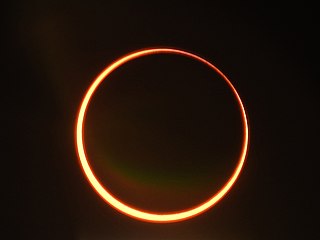| Solar eclipse of December 26, 2019 | |
|---|---|
 Annularity as seen from Jaffna, Sri Lanka | |
| Type of eclipse | |
| Nature | Annular |
| Gamma | 0.4135 |
| Magnitude | 0.9701 |
| Maximum eclipse | |
| Duration | 220 s (3 min 40 s) |
| Coordinates | 1°00′N 102°18′E / 1°N 102.3°E |
| Max. width of band | 118 km (73 mi) |
| Times (UTC) | |
| Greatest eclipse | 5:18:53 |
| References | |
| Saros | 132 (46 of 71) |
| Catalog # (SE5000) | 9552 |
An annular solar eclipse occurred at the Moon’s descending node of orbit on Thursday, December 26, 2019,[1][2][3][4][5] with a magnitude of 0.9701. A solar eclipse occurs when the Moon passes between Earth and the Sun, thereby totally or partly obscuring the Sun for a viewer on Earth. An annular solar eclipse occurs when the Moon's apparent diameter is smaller than the Sun's, blocking most of the Sun's light and causing the Sun to look like an annulus (ring). An annular eclipse appears as a partial eclipse over a region of the Earth thousands of kilometres wide.[6] The Moon's apparent diameter was near the average diameter because it occurred 7.3 days after perigee (on December 18, 2019, at 20:25 UTC) and 6.2 days before apogee (on January 2, 2020, at 1:30 UTC).[7]
Annularity was visible in Saudi Arabia, Qatar, United Arab Emirates, Oman, southern India, Sri Lanka, Malaysia, Indonesia, Singapore, the Northern Mariana Islands, and Guam. A partial eclipse was visible for parts of East Africa, Asia, and northern Australia.
- ^ "December 26, 2019 Annular Solar Eclipse". timeanddate. Retrieved 12 August 2024.
- ^ Cite error: The named reference
spacewas invoked but never defined (see the help page). - ^ Cite error: The named reference
abc7was invoked but never defined (see the help page). - ^ Cite error: The named reference
nprwas invoked but never defined (see the help page). - ^ Cite error: The named reference
reutwas invoked but never defined (see the help page). - ^ Cite error: The named reference
eclipsewisewas invoked but never defined (see the help page). - ^ "Moon Distances for London, United Kingdom, England". timeanddate. Retrieved 12 August 2024.
